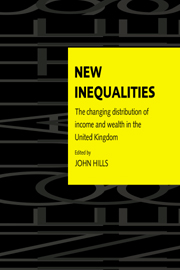Book contents
- Frontmatter
- Contents
- List of figures
- List of tables
- List of contributors
- Acknowledgements
- 1 Introduction: after the turning point
- Part I Income distribution
- Part II Components of income
- Part III Spatial aspects
- Part IV Income and wealth
- 13 Patterns of financial wealth-holding in the United Kingdom
- 14 Home-ownership, housing wealth and wealth distribution in Britain
- Bibliography
- Index
14 - Home-ownership, housing wealth and wealth distribution in Britain
from Part IV - Income and wealth
Published online by Cambridge University Press: 22 September 2009
- Frontmatter
- Contents
- List of figures
- List of tables
- List of contributors
- Acknowledgements
- 1 Introduction: after the turning point
- Part I Income distribution
- Part II Components of income
- Part III Spatial aspects
- Part IV Income and wealth
- 13 Patterns of financial wealth-holding in the United Kingdom
- 14 Home-ownership, housing wealth and wealth distribution in Britain
- Bibliography
- Index
Summary
Introduction
The level of home-ownership in Britain has increased rapidly during the last 40 years. In 1950 there were some 4 million owner-occupied dwellings, 29 per cent of the total. By 1990, there were 15 million owner-occupied dwellings, 67 per cent of total dwellings (Department of the Environment, 1993; CML, 1994). The 30 years from 1960 to 1989 also saw rapid house price inflation over and above the general level of inflation. National average house prices rose from £2500 in 1960 to £5000 in 1970 and £65,000 in 1990 (CML, 1994). This represents an increase of 1200 per cent in nominal terms in just 20 years, and in real terms the value of housing has risen about three-fold (Holmans, 1990). These trends, the growth of home-ownership and house-price inflation have, between them, led to major changes in the importance of property ownership in personal wealth and in inheritance. Not only do many home-owners now own a substantial asset, but a large proportion of both wealth and inheritance now consists of housing (Forrest and Murie, 1989; Hamnett, 1993).
Housing and the distribution of wealth
The Royal Commission on the Distribution of Income and Wealth (1977) estimated that the value of dwellings as a proportion of net personal wealth increased from 18 per cent in 1960 to 37 per cent in 1975, and this had risen to just over 53 per cent by 1990.
- Type
- Chapter
- Information
- New InequalitiesThe Changing Distribution of Income and Wealth in the United Kingdom, pp. 348 - 373Publisher: Cambridge University PressPrint publication year: 1996
- 3
- Cited by



